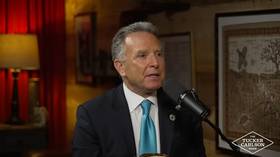50th anniversary of Tsar bomb (VIDEO)
It is exactly 50 years since the USSR tested the most powerful hydrogen bomb ever made.
On October 30 1961, a specially modified Tu-95 strategic bomber enveloped in a protective white coating dropped a powerful hydrogen bomb at a testing range on Novaya Zemlya in the Arctic Ocean. The bomb was parachuted from 10,500 meters so that the bomber and a flying laboratory that was collecting data had time – 188 seconds – to leave the area.The bomb detonated at an altitude of 4,200 meters. The unprecedented explosion was expected to measure 51.5 megatons. In reality, its power was estimated at between 57 and 58.6 megatons. One of the groups participating in the experiment, almost 200 miles away from the epicenter, saw a bright flash even with dark glasses on. The filming crew on board the carrier plane, in charge of making a documentary, recalled, “Outside, there was a sea of light, an ocean of light suddenly bursting out… Once our plane came out of the clouds, in between them, a huge balloon of bright orange color appeared! It was like Jupiter – powerful, and conceited, and confident, slowly and silently crawling up…”The ball of fire had a radius of 4.6 kilometers and was visible from a distance of 1,000 km, despite dense clouds. The mushroom of the explosion rose up to 67 km and had a diameter of 95 km.For about 40 minutes after the explosion, radio signal distortions were observed hundreds of kilometers from the epicentrum due to ionization of the atmosphere.The blast wave circled the planet three times. On Dikson Island, some 800 km from the range, the wave blasted out windows, bringing the sound of cannonade with it.
The initial thermonuclear device, dubbed “Ivan” by scientists, was developed by a group of Soviet physicists headed by academician Igor Kurchatov and Nobel prize-winning Andrey Sakharov in the mid-1950s. Kurchatov died in 1960, but Sakharov lived long enough to see all versions of the future AN602 bomb. The original bomb was supposed to weigh in at 40 tons. However, not long before the “big bang” it was pared down to a more modest 26.5 tons at the request of the designers of the carrier plane, and its explosive potential reduced. Yet despite its smaller size, the bomb still failed to fit inside the body of the plane and protruded from the bomb bay during flight.
In 1950s, it was proved that there was no limit to the power of the hydrogen bomb, so it was decided to test a bomb of 100 megatons. After consideration, its power was limited to 51 megatons for only one reason – the construction of such a bomb meant it would be too dirty in terms of nuclear fallout. The additional layer of Uranium-238 of the third stage of the bomb was replaced with plumbum, also reducing the bomb’s weight by one ton.In the event, the bomb proved to be relatively clean, as up to 97 per cent of its power was created by radiation-free thermonuclear synthesis.The power of the explosion exceeded the combined power of all explosives used by all countries during WWII. The explosive energy released exceeded 3,800 times the Fat Man bomb dropped on Hiroshima and Nagasaki.The bomb and specially-modified bomber were actually ready in 1959, but testing was postponed until after a planned visit to the US by Soviet Leader Nikita Khrushchev aimed at defusing diplomatic tensions.The Soviet Union had two nuclear ranges: one near Semipalatinsk in Kazakhstan, and the other on Novaya Zemlya. The latter went into operation in 1954 and continued until October 26, 1991, when President Boris Yeltsin signed a moratorium on nuclear tests. A total of 132 nuclear tests were carried out on this range: 87 in the atmosphere, 42 underground and three underwater.














